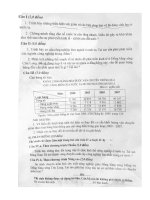Olympic Vật lý quốc tế 2010 - Lời giải môn vật lý.PDF
Bạn đang xem bản rút gọn của tài liệu. Xem và tải ngay bản đầy đủ của tài liệu tại đây (397.03 KB, 4 trang )
41st International Physics Olympiad, Croatia – Theoretical competition, July 19th, 2010
1/4
Solution - Chimney physics
This problem was inspired and posed by using the following two references:
W.W. Christie, Chimney design and theory, D. Van Nostrand Company, New York, 1902.
J. Schlaich, R. Bergermann, W. Schiel, G. Weinrebe, Design of Commercial Solar Updraft
Tower Systems — Utilization of Solar Induced Convective Flows for Power Generation, Journal
of Solar Energy Engineering 127, 117 (2005).
Solution of Task 1
a) What is the minimal height of the chimney needed in order that the chimney functions
efficiently, so that it can release all of the produced gas in the atmosphere?
Let
)(zp
denote the pressure of air at height z; then, according to one of the assumptions
gzpzp
Air
)0()(
, where
)0(p
is the atmospheric pressure at zero altitude.
Throughout the chimney the Bernoulli law applies, that is, we can write
.)()(
2
1
2
constzpgzz
SmokeSmokeSmoke
,
(1)
where
)(zp
Smoke
is the pressure of smoke at height z,
Smoke
is its density, and
)(zv
denotes the
velocity of smoke; here we have used the assumption that the density of smoke does not vary
throughout the chimney. Now we apply this equation at two points, (i) in the furnace, that is at point
z
, where
is a negligibly small positive number, and (ii) at the top of the chimney where
hz
to obtain:
)()()(
2
1
2
SmokeSmokeSmokeSmoke
phpghh
(2)
On the right hand side we have used the assumption that the velocity of gases in the furnace is
negligible (and also
0
g
Smoke
).
We are interested in the minimal height at which the chimney will operate. The pressure of smoke at
the top of the chimney has to be equal or larger than the pressure of air at altitude
h
; for minimal
height of the chimney we have
)()( hphp
Smoke
. In the furnace we can use
)0()( pp
Smoke
. The
Bernoulli law applied in the furnace and at the top of the chimney [Eq. (2)] now reads
)0()()(
2
1
2
phpghh
SmokeSmoke
.
(3)
From this we get
12)(
Smoke
Air
ghh
.
(4)
The chimney will be efficient if all of its products are released in the atmosphere, i.e.,
41st International Physics Olympiad, Croatia – Theoretical competition, July 19th, 2010
2/4
A
B
h )(
,
(5)
from which we have
1
1
2
1
2
2
Smoke
Air
g
A
B
h
.
(6)
We can treat the smoke in the furnace as an ideal gas (which is at atmospheric pressure
)0(p
and
temperature
Smoke
T
). If the air was at the same temperature and pressure it would have the same
density according to our assumptions. We can use this to relate the ratio
SmokeAir
/
to
AirSmoke
TT /
that is,
Air
Smoke
Smoke
Air
T
T
, and finally
(7)
T
T
g
A
B
TT
T
g
A
B
h
Air
AirSmoke
Air
2
1
2
1
2
2
2
2
.
(8)
For minimal height of the chimney we use the equality sign.
b) How high should the chimney in warm regions be?
mh
TT
T
TT
T
h
h
Smoke
Smoke
145)30(;
)30(
)30(
)30(
)30(
)30(
)30(
.
(9)
c) How does the velocity of the gases vary along the height of the chimney?
The velocity is constant,
AirAir
Smoke
Smoke
Air
T
T
gh
T
T
ghgh
21212
.
(10)
This can be seen from the equation of continuity
.constAv
(
Smoke
is constant). It has a sudden
jump from approximately zero velocity to this constant value when the gases enter the chimney from
the furnace. In fact, since the chimney operates at minimal height this constant is equal to
B
, that is
ABv /
.
d) At some height z, from the Bernoulli equation one gets
gzghpzp
SmokeSmokeAirsmoke
)()0()(
.
(11)
Thus the pressure of smoke suddenly changes as it enters the chimney from the furnace and acquires
velocity.
41st International Physics Olympiad, Croatia – Theoretical competition, July 19th, 2010
3/4
Solution of Task 2
a) The kinetic energy of the hot air released in a time interval
t
is
Atm
HotHotkin
T
T
ghtAvvtAvE
2
)(
2
1
,
(12)
Where the index “Hot” refer to the hot air heated by the Sun. If we denote the mass of the air that
exits the chimney in unit time with
Hot
Avw
, then the power which corresponds to kinetic
energy above is
Air
kin
T
T
wghP
.
(13)
This is the maximal power that can be obtained from the kinetic energy of the gas flow.
The Sun power used to heat the air is
TwcGSP
Sun
.
(14)
The efficiency is evidently
.
AtmSun
kin
cT
gh
P
P
(15)
b) The change is apparently linear.
Solution of Task 3
a) The efficiency is
%64.00064.0
Atm
cT
gh
.
(16)
b) The power is
45)2/(
2
DGGSP
kW.
(17)
c) If there are 8 sunny hours per day we get 360kWh.
Solution of Task 4
The result can be obtained by expressing the mass flow of air
w
as
Hot
Air
Hot
T
T
ghAAvw
2
(18)
Tc
GS
w
(19)
which yields
1.9)
2
(
3/1
222
22
ghcA
TSG
T
Hot
Atm
K.
(20)
41st International Physics Olympiad, Croatia – Theoretical competition, July 19th, 2010
4/4
From this we get
760w
kg/s.
(21)









